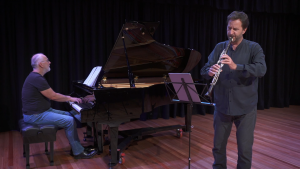Listening Between The Notes: Katy Abbott's Still

Learn from the composer and performers, and watch the premiere performance.
Still for clarinet and piano, by Katy Abbott, our latest commissioned Australian composer, score enquiries via the composer.
Duration: ca. 5:15 minutes
Instrumentation: Clarinet in Bb and Piano
Program Note
This piece was warmly commissioned by Australia Ensemble UNSW.
“The focus is less on virtuosic playing but rather to reflect further on what I’ve learned during a much quieter and more ‘still’ few months. I think creating metaphorical space within the music, through stillness, beauty and simplicity creates potential and capacity for audience reflection which both stimulates curiosity about ourselves and each other as well as inform us about how we show up in the world.” This statement was written for the commissioner before the piece was composed and was indeed how the work came into being.The spaciousness within the piece provides an upside-down virtuosity – a way for the duo to connect deeply through the music; the space provides exposure – which although beautiful, is also vulnerable, fragile. The first lockdown in Melbourne provided space for me to regroup which is where the concept was initiated. The second lockdown, the one we are still in as we write, is more about personal capacity. I’ve watched my family, friends, neighbours and colleagues wrestle, push and tire. All with terrific attitudes. This piece was the only piece that could be composed (for me) during this time. I hope it is one of peace and hope. My home office looks out to my front verandah and I’ve spent many days looking at the sunlight dappled through the lovely twisted gum tree. This reminds me of strength and stillness which I’m sure is represented in the work somehow.
It is my hope Still is not packaged into ‘a lockdown’ piece box but speaks more broadly to an audience of musical and human qualities through the performer’s interpretation. Katy Abbott, October 2020.
Read our interview with composer Katy Abbott here where she discusses how, after a difficult year in Melbourne, Abbott has found peace and hope in composing for David Griffiths and Ian Munro.
Transcript
00:00 - Introduction by Dr Katy Abbott
Hello there, I’m Dr Katy Abbott and I was thrilled to write Still for the Australia Ensemble last year during 2020. When I was writing the piece, it was smack in the middle of Melbourne’s second lockdown, you know the really long one, and Still is exactly the piece that I wanted to write at that time. I hope it is not packaged as a lockdown piece and that it doesn’t become known as a lockdown piece just because it happened to be written in 2020 but because I believe the piece speaks more broadly to an audience of musical and human qualities through the performer’s interpretation.
On the page the piece looks really sparse, and quite simple but it’s difficult in some ways for the performers because it is vulnerable and exposing, and I suppose this is how we were feeling wasn’t it, last year in 2020. So, I wanted a way for the audience to be able to empathise with the performers but also for the performers to empathise with where we found ourselves in the world at that time.
I hope that Still creates capacity for an audience reflection that stimulates curiosity. Curiosity about ourselves and how we show up in the world and the way that we live. So, by creating a metaphorical space within the music through the stillness and the spaces between the notes as well, I believe that that is where capacity is born from. Thank you.
01:37 - Performance of Still
07:57 - Inside the Music with David Griffiths, clarinet and Ian Munro, piano
David Griffiths: So the… probably the biggest technical challenge of this piece is the control of the notes in many, many ways, so starting the note for instance, the very first note she writes to start from nothing, and clarinet more than any other wind instrument can do that incredibly well. But, it is still very challenging to really start it from nothing without any sort of attack on the note, but really the biggest challenge overall is the stamina to play this sort of, 5 minute work, where there is very little room for breathing and extremely long notes with extremely… strong amounts of breath control is required. Some of the other challenges are the big sort of interval leaps up to the high C sort of midway through the climactic moment and holding that high C for eternity, it is probably the longest one ever, so this piece for instance is actually much, much harder than many people would think by looking at it. I would find it much easier playing something say, faster and technically challenging in the more traditional sense.
If a student was to want to learn this piece, I think the sort of technical things that they should do would be a lot of long tone exercises, and there are many, many different types of ones that you can do, but just exercises that really develop really good breathing technique from… you see me patting my stomach, from breathing down low. I make all my students do 20 seconds long note exercises that start very soft that go loud and back to soft, through all the ranges of the clarinet, that would be one really good exercise, but you really could spend 30 minutes a day just playing long notes if you have the sort of mental fortitude for it, but it is the sort of thing that you would need to be able to play this piece well.
Ian Munro: I guess the challenge of playing with wind players as a pianist or in fact with any other instrument is really listening to the characteristics of those instruments, and they are very different between strings and wind players. The clarinet can do these wonderful… starting from nothing breathing crescendos, of course the piano can’t do, but what the piano can do that pretty much no instrument can, is create its own acoustic with the pedal. The pedal is a magical thing that Chopin famously liberated so, if I have Dave standing in front of me, I can immediately sort of, open up the air for him by putting my pedal down and so whatever he does, even if I am not doing anything at all, I enliven the air, that he is occupying, so really listening as pianist to the vibrations in the air rather than concentrating on ones fingers are doing is the absolute first thing that one must do and that’s just part of learning to listen as a musician.
Many things that pianists concentrate on, mainly the fingers, very preoccupied with busy fingers, that is all very well, but the real art of playing the piano on ones own or with other players is to listen to the sound, the air that’s coming out.
I particularly like it when your colleague only notices you’re doing it down the track, you know, you just surreptitiously pedal with them even though you are not doing anything yourself so that you are changing the air. I love doing that. It is a bit sneaky but also complementary.
David Griffiths: Yeah…I, I…. hearing you say all that sort of , like you said, I am thinking about these things that are happening without me being aware of that and for me what I love about playing this piece actually with Ian , I feel like we sort of get inside each other’s sound and create something completely different, and we are not just playing together, but inside each other’s sounds if you like, and not everyone can do that so well, I guess.
Ian Munro: I think that Katy is exploring that in this piece too, she is… for instance she asks me to... at many points, she asks me to breathe in sympathy with Dave, and of course there is no reason why I should breathe, I do breathe but it is something you don’t think about but she makes me consciously breathe with him, and I feel like she is playing with the idea of the exact mixture of sound that you get when you attack a note with the piano, when I say attack it doesn’t need to be a big sound, but you necessarily have to begin a note in a different way to the clarinet, and when you combined that with the way the clarinet player begins a note which can be terribly soft, you put those two things together and you get a third sound and I think a lot of this piece is working with that principle that the result is more than the sum of the parts.
David Griffiths: Exactly, yeah.
